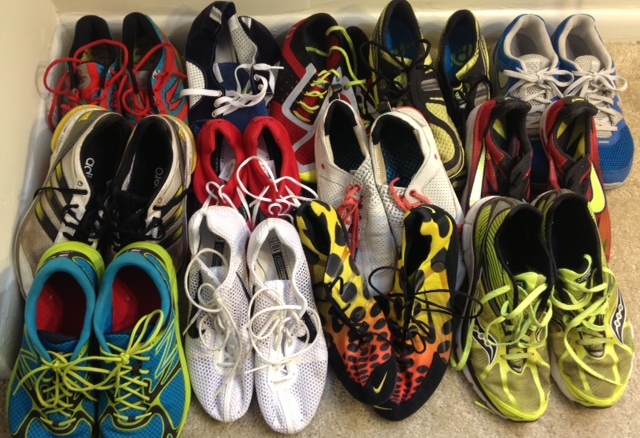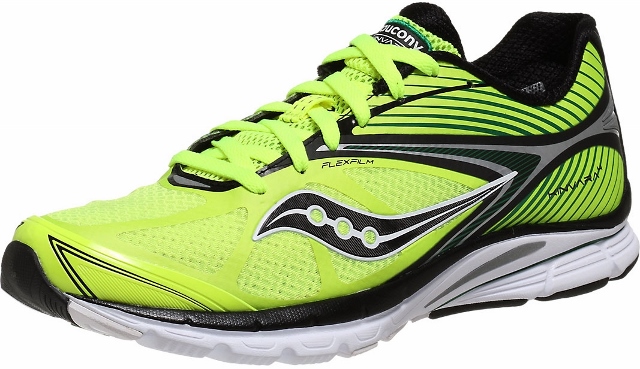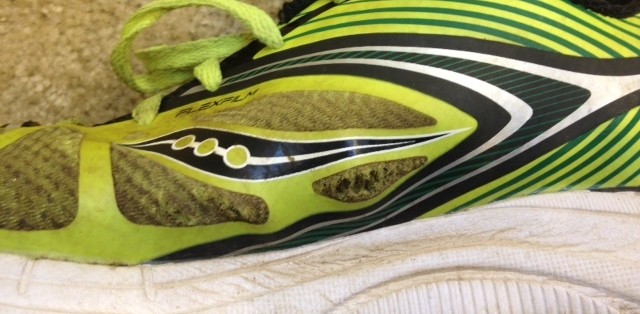I go through running shoes like most people go through underwear. And to top it off, I fully admit to an unhealthy obsession with new shoes.

When you run 75+ miles every week, a shoe can be past its prime after only a month. I rotate two pairs of running shoes so they last double that time, but it’s an expensive habit.
The benefit of feeling like a kid on Christmas with every UPS delivery is that I can test a lot of models. The Saucony Kinvara 4 is my latest experiment in finding the perfect pair of shoes (this mission is a failure so far).
I’ve worn an earlier Kinvara model – this ain’t my first rodeo. But I stayed away from the Kinvara for two years because I didn’t love them.
The toebox was wide at the end of my toes and I felt like my foot slid around in the shoe. Yet I also thought the toebox was too narrow at the base of my toes – and I got my first (and only) black toenail ever from the Kinvara.
Time heals all things so a few months ago I gave them another chance and bought the Saucony Kinvara 4 model:

It’s better than the second iteration of the shoe in my opinion – but far from my ideal shoe.
Saucony Kinvara 4 Specs
The Kinvara 4 is labeled a “performance neutral” running shoe which means that it’s sold to folks who fit a particular profile: efficient runners who are light, favor faster running, and are able to train in a minimalist running shoe.
Unfortunately, these runner profiles are largely bogus. One of the lessons in Peter Larson’s excellent book Tread Lightly is that you can’t buy shoes based on arch height and body frame (even though that’s what most manufacturers and retailers try to do).
A better way to determine what shoe to wear is to make sure the fit feels good and that you’re ready to run in the type of shoe you’re about to purchase.
Never run in a minimalist pair of shoes? The Merrell Trail Gloves are probably too aggressive for you.
Here’s how the Saucony Kinvara 4 measures:
- 7.7 ounces for a men’s size 8
- 4mm heel-toe drop
- New “PowerGrid” sole (updated from “ProGrid”)
- Thin, lightweight upper made from “FlexFilm” material
The new sole is coined PowerGrid from the previous ProGrid iteration, though I didn’t notice at all. It’s a relatively soft, cushioned sole so if you’re expecting a more responsive, firm ride then the Saucony Kinvara probably isn’t for you.
I do about 75% of my running on trails so the combination of a soft sole and a dirt path gave a very cushioned ride. Normally I prefer a shoe with a very firm sole so that my trail runs are more responsive. This isn’t a deal-breaker for me, though!
The lightweight upper is made from very thin material and durability is unfortunately compromised. Even with only about 350 miles on my pair, the upper ripped on the medial side of the shoe near my arch. It seems there’s a trade-off with performance materials and durability (which is expected) so keep that in mind.
My Personal Opinion on the Kinvara 4
The most surprising aspect of this shoe is that the foot bed felt uneven or not quite level. I pronate significantly but still felt like my foot was supinating as the sole veered to the outer side of the shoe. I didn’t notice this while running, but during my warm-up routine it felt uncomfortable.
Not only did the foot bed feel uneven, but the sole was also too wide for my average sized foot (size 10). To compensate, I tied the shoes very tight but the roomy toebox, light upper material, and wide sole made it feel like there was too much room inside the shoe.
Would these drawbacks stop me from buying another pair? No. But next time I won’t run as much in the Kinvaras and instead choose a more stable shoe for the bulk of my mileage.
Next is the upper. It was fine – nothing I absolutely loved or disliked. It was light but otherwise seemed average with no extraordinary characteristics. Like I mentioned, performance fabric and other materials typically have a shorter lifespan.
And the Saucony Kinvara 4’s lightweight upper is no exception. Within 200 miles, the inside of the arch on the right foot ripped slightly and the hole is only getting bigger. Even though I have about 350 miles on them, the hole didn’t get too large or compromise the ride of the shoe. So at the end of the day it’s not a deal breaker for me.

“I’m a new runner – are the Kinvaras a good shoe for me?”
Good question! It depends on how comfortable you are in low heel-toe drop shoes and whether you like a softer, more cushioned running shoe.
The Kinvaras are a good option for many runners who want to gradually run in a more minimalist shoe but don’t want to dive head first into doing 100% of their training barefoot (which is an excellent idea). Consider it an introductory minimalist shoe.
If you have no problems in other low heel-toe drop shoes and prefer cushioned, light trainers then the Kinvara could be a great option for you.
“I like the Kinvara but want something with more cushioning. Suggestions?”
First take a look at the Strength Running Running Shoe Reviews area to get to know similar models.
I recommend testing the K-Swiss Kwicky Blade Light and the ASICS Gel-Blur 33. But in general, I don’t like recommending shoes because every runner has individual needs, biomechanics, inefficiencies, and training patterns so it’s up to you to find something that works.
And note that I used the word “testing” above. Shoes come in all different shapes, weights, heel-toe drops, widths, and other variations. Only you will know exactly what feels right when you’re out running!
“If I wear the Saucony Kinvara 4’s, what shoe should I rotate them with?”
It depends on what type of runner you are. Since the Kinvaras have a 4mm heel-toe drop, that should be a big influence on your other shoe.
Very comfortable in low heel-toe drop shoes? Get a similar pair of shoes like the Newton Gravity or Minimus Road.
Need a more supportive shoe? Try something like the Adidas AdiZero Boston.
Your running shoes should reflect a variety in heel-toe drop, cushioning, and weight. But above all, make sure they just feel good when you’re running. And if you find a shoe that you absolutely love, stick with it!
My question for you: if you’ve run in the Saucony Kinvara, what’s your biggest compliment and most negative criticism?
Leave your answer in the comments below. And if you want to test the Kinvara 4, the best deal seem to be on Amazon here.